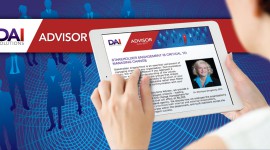09 Feb
2016
AN INCREASING VETERAN WORKFORCE WILL CHANGE THE WAY ORGANIZATIONS DO BUSINESS
Civilian agencies and public sector companies will see the way they do business change as our veteran workforce continues to grow. The needs of veterans and their families change on an ongoing basis, and employers—all employers—will need to embrace these changes. Organizations must ensure that they stay on top of this changing veteran landscape and foster a deep understanding and awareness of needs and requirements and how to respond to them.
As more organizations hire veterans, being aware of their key issues will help shape hiring approaches. Deployments to Iraq and Afghanistan and the ensuing drawdowns of forces have created needs on a number of different fronts—especially within the ranks of the National Guard and Reserve. Organizations like the DOD’s Employer Support of the Guard and Reserve (ESGR) and Yellow Ribbon Reintegration Program (YRRP) provide services that bolster communications between those who are deployed and their families. This, along with the cooperation of civilian employers on the home front, helps ensure smoother transitions back to the civilian workforce for service members. Programs like the Secretary of Defense Employer Support Freedom Award inspire employer awareness and participation by honoring civilian employers who go above and beyond in support of the Guard and Reserve. Reintegration challenges demand robust communication to ensure that veterans and their families are aware of all options available to them as they traverse what can be a difficult landscape.
Female veterans’ growing numbers and changing needs require enhanced understanding and resource-building. Women make up the fastest-growing group in our nation’s veteran community. This has prompted agencies like the Department of Labor, Women’s Bureau, to work to develop tools to help employers better understand women veteran issues and provide women veterans with the resources they need to find civilian careers.
Learning and education are also critical in meeting the needs of a growing veteran workforce. They are important for both employees who share a role in veterans’ successful transitions to the civilian workforce and veterans themselves in developing skills to conduct successful job searches. The Department of Veterans Affairs (VA) has been addressing this for years. Through programs like VA for Vets, the Veteran Employment Services Office (VESO) trains and educates veteran applicants and VA supervisors, HR professionals and hiring managers in their effort to ensure best practices in recruiting, hiring and retaining veteran employees in the federal government. VA Learning University (VALU) develops and delivers technical learning courses for VA employees and conducts in-person and virtual recruiting events for veteran job-seekers to connect them to open positions and career support in their own communities—helping thousands of veterans receive career coaching, resume, and job application assistance and interview preparation.
It is critical that organizations supporting veterans stay relevant to those they support through the understanding of evolving issues and awareness of the wide array of resources available to veterans, their families, and employers. Employers who will make a real difference will be those who adjust how they do business, the work environments that they create, and ongoing employee development and learning well after a veteran is hired.




